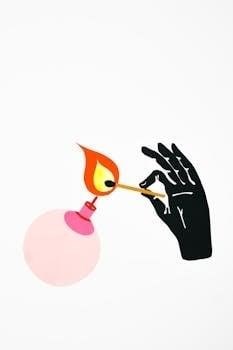
Fire Alarm Symbols for Drawings (PDF Focus)
This section focuses on the importance of using standardized symbols for fire alarm systems within technical drawings. NFPA 170 provides standard symbols that are used to communicate fire safety and emergency information. Accessing PDF resources is crucial for confirming symbol meanings and ensuring accurate interpretation.
Technical drawings related to fire alarm systems require a clear and concise language for representing various components. This is achieved through the use of standardized symbols. These symbols act as visual shorthand‚ allowing engineers‚ architects‚ and installers to quickly understand the layout and functionality of a fire alarm system. Imagine trying to decipher a complex system without consistent symbols – it would lead to confusion‚ errors‚ and potential safety hazards.
These symbols represent elements such as smoke detectors‚ manual pull stations‚ audible alarms‚ and control panels. The symbols are combined to form a complete representation of a fire protection system. Understanding the specific meaning of each symbol is essential for accurate interpretation of drawings.
NFPA 72 requires that all fire alarm drawings use the symbols described in NFPA 170 (Standard for Fire Safety and Emergency Symbols). Without standardization‚ the potential for miscommunication and errors increases significantly. Therefore‚ familiarity with these symbols is critical for anyone involved in the design‚ installation‚ or maintenance of fire alarm systems.
Importance of Standardized Symbols
Standardized symbols are paramount in fire alarm system drawings due to their ability to foster clear communication and minimize ambiguity. Imagine the chaos if every designer used their own unique symbols. The potential for misinterpretation would skyrocket‚ leading to installation errors‚ delayed projects‚ and‚ most critically‚ compromised safety. Standardized symbols ensure that everyone involved‚ from architects and engineers to installers and inspectors‚ speaks the same visual language.
These symbols provide a consistent and universally understood method for representing components like smoke detectors‚ pull stations‚ and alarm bells. This consistency is crucial for accurately conveying the system’s design and functionality. Furthermore‚ standardized symbols streamline the review and approval process by making it easier for authorities having jurisdiction (AHJs) to assess compliance with safety codes.
By adhering to standards like NFPA 170‚ we minimize the risk of errors and ensure that fire alarm systems are installed and maintained correctly‚ ultimately protecting lives and property. The use of standardized symbols is not just a matter of convenience; it is a fundamental aspect of responsible fire protection engineering.

NFPA 170⁚ Standard for Fire Safety and Emergency Symbols
NFPA 170‚ the Standard for Fire Safety and Emergency Symbols‚ plays a crucial role in ensuring clear and consistent communication related to fire safety‚ emergency systems‚ and associated hazards. This standard establishes a uniform set of symbols intended for use in architectural and engineering drawings‚ as well as other visual representations.
The primary objective of NFPA 170 is to minimize confusion and enhance comprehension by providing standardized symbols for various fire protection and life safety elements. These symbols cover a wide range of components‚ including fire extinguishers‚ fire alarm devices‚ evacuation routes‚ and hazardous material locations.
By adhering to NFPA 170‚ professionals involved in building design‚ construction‚ and maintenance can ensure that critical safety information is conveyed accurately and effectively. This standardization is essential for facilitating rapid response during emergencies and promoting overall safety awareness. Moreover‚ NFPA 170 ensures that fire alarm drawings use the described symbols unless other symbols are acceptable to the AHJ. Staying informed and participating in the standards development process for NFPA 170 is paramount for its continued relevance and effectiveness.
Relationship to NFPA 72
The relationship between NFPA 170 and NFPA 72 is vital for ensuring comprehensive fire safety in building design and operation. NFPA 72‚ the National Fire Alarm and Signaling Code‚ relies heavily on the standardized symbols defined in NFPA 170 for accurate representation of fire alarm systems in technical drawings. Specifically‚ NFPA 72 mandates that all fire alarm drawings must utilize the symbols described in NFPA 170 unless alternative symbols are explicitly approved by the Authority Having Jurisdiction (AHJ).
This requirement ensures consistency and clarity in the documentation of fire alarm systems‚ enabling stakeholders‚ including designers‚ installers‚ inspectors‚ and emergency responders‚ to readily understand the system layout and functionality. By adhering to NFPA 170 symbols‚ NFPA 72 promotes effective communication and reduces the risk of misinterpretation‚ ultimately enhancing the reliability and effectiveness of fire alarm systems.
The integration of NFPA 170 symbols within NFPA 72 underscores the importance of standardized visual communication in fire safety. This alignment ensures that fire alarm systems are accurately depicted‚ facilitating proper installation‚ maintenance‚ and emergency response‚ thereby safeguarding lives and property.
BS 1635⁚ 1990 ⎯ Graphic Symbols for Fire Protection Drawings (UK Standard)
BS 1635⁚ 1990 represents the British Standard providing recommendations for graphic symbols and abbreviations specifically tailored for fire protection drawings. This standard serves as a crucial guide for professionals involved in architectural‚ engineering‚ and construction projects within the United Kingdom‚ ensuring clarity and consistency in the representation of fire safety equipment and systems.
Complementing broader drawing conventions outlined in BS 1192⁚ 2007‚ which focuses on collaborative production of architectural‚ engineering‚ and construction information‚ BS 1635⁚ 1990 offers detailed specifications for symbols related to fire alarms‚ extinguishers‚ sprinkler systems‚ and other fire protection measures. By adhering to this standard‚ designers and engineers can effectively communicate the layout and functionality of fire protection systems‚ facilitating accurate installation‚ maintenance‚ and emergency response.
While NFPA standards are prevalent in North America‚ BS 1635⁚ 1990 remains a relevant resource for projects adhering to UK regulations or referencing British standards. Understanding these symbols is essential for interpreting fire protection drawings created according to UK practices‚ promoting effective collaboration and ensuring the safety and compliance of buildings.
Common Fire Alarm Symbols and Their Meanings
Understanding the common fire alarm symbols is crucial for interpreting technical drawings accurately. These symbols‚ often standardized by NFPA 170‚ represent various components of a fire alarm system. A manual pull station‚ for instance‚ has a distinct symbol indicating its location for manual activation. Smoke detectors‚ whether ionization or photoelectric‚ also have their own unique symbols‚ differentiated by internal mechanisms.

Audible alarm devices‚ such as bells‚ horns‚ and strobes‚ are represented with symbols that convey their function as alerting mechanisms. A water flow switch‚ critical for sprinkler systems‚ has a symbol indicating its role in detecting water flow. Furthermore‚ the power booster panel and fire alarm panel‚ the central control units‚ also have specific symbols. These symbols ensure that all elements of the fire alarm system are clearly identified on architectural and engineering drawings.
Correct interpretation of these symbols is essential for proper installation‚ maintenance‚ and emergency response‚ making it a vital skill for anyone working with fire safety systems.
Manual Pull Station
The manual pull station is a critical component of any fire alarm system‚ allowing individuals to manually initiate an alarm in the event of a fire. Its symbol on fire protection drawings is standardized to ensure clear identification and understanding across various plans and projects. Typically‚ the symbol represents a rectangular or square device‚ often with an activation lever or button‚ mounted on a wall at a specified height‚ usually around 48 inches to the handle.
The symbol’s orientation does not indicate the direction of propagation but merely its location. The representation should be consistent with standards like NFPA 170 to avoid confusion. In technical drawings‚ the manual pull station symbol must be clear and distinct from other fire protection equipment. The symbol often includes an abbreviation like “MPS” or a similar identifier to confirm its purpose.
Correct placement and visibility of manual pull station symbols on drawings are essential for efficient emergency response planning and system maintenance. This enables quick identification of the device’s location during an actual fire emergency.
Smoke Detector Symbols (Ionization and Photoelectric)
Smoke detectors are vital components of fire alarm systems‚ designed to detect the presence of smoke‚ thereby providing early warning of a fire. In technical drawings‚ distinct symbols represent different types of smoke detectors‚ primarily ionization and photoelectric. These symbols must adhere to standards like NFPA 170 for consistency.
The symbol for an ionization smoke detector is often represented by a circle with the letters “SI” inside‚ while a photoelectric smoke detector is similarly depicted with “SP.” These symbols are essential for differentiating between the detector types on architectural and engineering drawings. The orientation of the symbol does not denote the direction of propagation.
Both ionization and photoelectric smoke detectors are crucial for comprehensive fire protection‚ and their accurate representation on drawings facilitates proper installation and maintenance. Duct-mounted smoke detectors may have a different symbol or a modified version of the standard smoke detector symbol with an indication of its location within the ductwork.
Audible Alarm Devices (Bells‚ Horns‚ Strobes)
Audible alarm devices are crucial components of fire alarm systems‚ designed to alert occupants in the event of a fire or emergency. These devices include bells‚ horns‚ and strobes‚ each with distinct symbols in technical drawings to ensure clarity and proper installation. Standardized symbols for these devices are typically outlined in NFPA 170.
A bell is often represented by a bell-shaped symbol‚ sometimes with a clapper depicted inside. Horns may be represented by a flared or trumpet-shaped symbol‚ indicating their sound-producing function. Strobes‚ which provide visual alerts‚ are typically represented by a lightning bolt or flashing light symbol‚ often enclosed in a square or rectangle.
The placement and type of audible alarm devices are critical for effective emergency communication. Drawings must clearly indicate the location of each device to ensure comprehensive coverage and audibility throughout the building. It’s important to check E-000 (The Legend) and RFI for any variations.
Water Flow Switch
A water flow switch is a crucial component in fire sprinkler systems‚ designed to detect the flow of water indicating that one or more sprinklers have been activated due to a fire. In technical drawings‚ the water flow switch is represented by a specific symbol to ensure its proper placement and connection within the fire protection system.
Typically‚ the symbol for a water flow switch includes a circle or square with an arrow indicating the direction of water flow. This symbol is often accompanied by the abbreviation “WFS” or a similar identifier. The water flow switch is often connected to the fire alarm control panel‚ triggering an alarm when water flow is detected. Accurate representation of water flow switch symbols is crucial for effective fire protection design and installation.
Referencing resources like E-000 (The Legend) can help confirm the correct interpretation of these symbols. Proper documentation and understanding of symbols ensures the correct placement of the water flow switch.

Power Booster Panel and Fire Alarm Panel Symbols
Power Booster Panels (PBP) and Fire Alarm Panels (FAP) are critical components of a fire alarm system‚ and their symbols in technical drawings are essential for proper installation and maintenance. The Fire Alarm Panel‚ often depicted as a rectangle or square with the letters “FAP” inside‚ serves as the central control unit for the entire fire alarm system‚ receiving signals from various initiating devices such as smoke detectors and pull stations.
Power Booster Panels‚ on the other hand‚ provide additional power to support the fire alarm system‚ especially when dealing with numerous devices or long wire runs. The PBP symbol is also typically a rectangle or square‚ labeled with “PBP”. Each power booster panel or fire alarm panel must be protected by a smoke detector. Area detectors within the same space will satisfy this requirement.
Accurate representation of these symbols on drawings ensures that technicians can easily identify the location and function of these critical components.

Finding Symbol Legends and Resources
Locating reliable symbol legends and resources is crucial for accurately interpreting fire alarm system drawings. The first place to check is the drawing set itself; engineered prints often include a legend sheet that defines each symbol used within that specific project. Look for E-000 which is The Legend sheet‚ avoid any overlapping symbols. If a legend is absent‚ request an RFI (Request for Information) from the engineer or project foreman.
National Fire Protection Association (NFPA) standards‚ specifically NFPA 170‚ are excellent resources. NFPA 170 provides standardized symbols for fire safety‚ emergency‚ and related hazards‚ ensuring consistency across different projects and jurisdictions. Moreover‚ online searches can lead to various resources‚ including manufacturers’ catalogs and technical documentation‚ that offer detailed symbol libraries.
Remember that fire alarm systems must have their own legend somewhere. Consulting multiple resources ensures correct understanding and avoids potential errors in installation or maintenance.
Accessing PDF Resources for Fire Alarm Symbols
Accessing PDF resources is vital for understanding fire alarm symbols used in technical drawings. These resources provide detailed visual representations and explanations of each symbol‚ ensuring accurate interpretation and application. The NFPA (National Fire Protection Association) website is a primary source‚ offering standards like NFPA 170 in PDF format‚ which outlines standard fire safety and emergency symbols.
Many manufacturers of fire alarm equipment also offer downloadable PDF catalogs and technical documents that include symbol legends specific to their products. These documents often provide greater detail and context for symbols related to particular devices‚ such as smoke detectors‚ pull stations‚ and alarm bells. Additionally‚ online libraries and repositories‚ may host collections of fire alarm system design guides and symbol libraries in PDF format.
Ensure the PDF resource aligns with relevant standards‚ such as NFPA 72‚ to maintain compliance. Always verify the source’s credibility to avoid using outdated or inaccurate information.